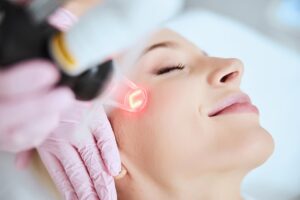How Do I Care for My Skin After Laser Resurfacing
 Laser skin resurfacing can be a transformative solution for addressing common signs of aging, including mild to moderate lines and wrinkles, sun damage, melasma, uneven skin tone, and more. However, patients can typically expect that the treated skin will be tender and vulnerable after the procedure and should plan for at least five to seven days of recovery. For the best outcome, proper care after the treatment is imperative for a safe, rapid, and optimal recovery.
Laser skin resurfacing can be a transformative solution for addressing common signs of aging, including mild to moderate lines and wrinkles, sun damage, melasma, uneven skin tone, and more. However, patients can typically expect that the treated skin will be tender and vulnerable after the procedure and should plan for at least five to seven days of recovery. For the best outcome, proper care after the treatment is imperative for a safe, rapid, and optimal recovery.
Below, our board-certified facial plastic surgeon in Northern Virginia—Albert Cytryn, MD—lends his expertise in laser skin resurfacing to share his 10 tips for recovery. He hopes that this guide will help you through the post-treatment healing process.
10 Tips for Recovery After Laser Skin Resurfacing
- Follow all post-treatment care instructions: Your provider will give specific details based on your individual treatment plan and recommendations for products to ensure the skin is properly cared for with high-quality, protective ingredients.
- Do not pick at flaking or peeling skin: This can be harmful to the healing and regenerative process.
- Stay hydrated: Drink plenty of water and keep the skin hydrated with an approved moisturizer.
- Sleep with your head elevated: Prop your head up with an additional pillow for a few days following treatment to promote healthy circulation.
- Stop smoking: Tobacco can slow down or even cause complications during the healing process.
- Avoid sun exposure: Try to stay out of the sun as much as possible, especially for the first full week after treatment.
- Protect the skin: Apply a high-SPF sunscreen that is formulated for sensitive skin (with active ingredients such as titanium dioxide or zinc oxide) and wear a hat. Avoid overexposure to the sun and reapply sunscreen as directed throughout the day.
- Use cool to lukewarm water for cleansing: Excessively hot water can damage the healing skin.
- No makeup for at least 10 days post-treatment: This helps to prevent the introduction of bacteria, minimizing the risk of infection.
- Practice good skincare: Gently cleanse your face with the recommended solution (a vinegar soak may be suggested)—and be sure to carefully blot the skin dry (no rubbing)—followed by moisturizing.
Laser Skin Resurfacing Recovery Timeline
Day of Treatment
Immediately following the treatment, a topical ointment will be applied to help soothe and hydrate the skin. This forms a seal and barrier over the newly treated skin while the regenerative process begins. If needed, cold compresses may be used to ease swelling and discomfort.
1 to 3 Days After Treatment
Begin gently cleansing the skin using a cool water temperature with approved, non-abrasive products four to five times per day along with the approved healing ointments, moisturizers, and sunscreen.
During the first three days after laser skin resurfacing, patients should avoid strenuous exercise, swimming, and excessive sweating to prevent breakouts and infection.
7 to 10 Days After Treatment
Generally, patients can resume using their normal skincare cleansers, serums, and regimens around this time if skin is no longer peeling or flaking. As mentioned above, hold off on wearing makeup for the first 10 days.
4 to 6 Weeks After Treatment
In most cases, it should be safe to start using retinoids and glycolic acid products four to six weeks after treatment. However, always confirm approval with your doctor, especially if you have a follow-up treatment planned.
Lastly, it is recommended to plan your treatment well in advance or long after big events or times where you may need to be outside, so that you may focus on a successful recovery.
To learn more about laser skin resurfacing and other facial rejuvenation treatments, or to schedule a consultation with Dr. Cytryn, please contact us today.
